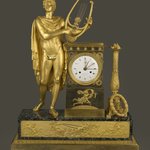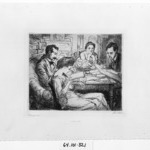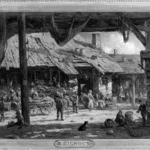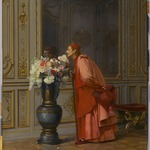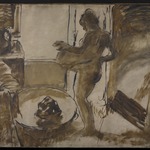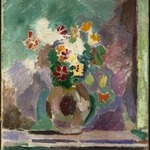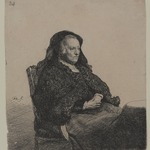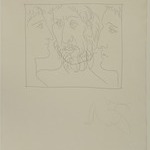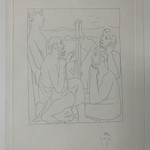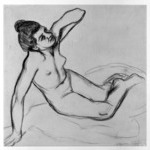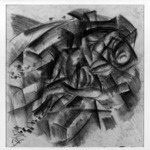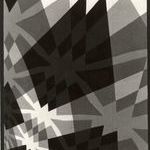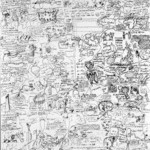
This image is presented as a "thumbnail" because it is protected by copyright. The Brooklyn Museum respects the rights of artists who retain the copyright to their work.
Nude Standing in Profile (Nu debout en profil)
Pablo Picasso
European Art
Pablo Picasso likely based the masklike facial features of this volumetric charcoal nude on Iberian sculptures from about 500–300 B.C.E. that he encountered at the Louvre in the winter of 1905–6. This is an early instance of his finding inspiration in art that was then called “primitive.” The term was used by a range of Western artists and writers in the nineteenth and early twentieth centuries to refer to the arts and peoples of Africa and Oceania, which they contrasted with their own culture’s supposed sophistication. This was a notion embedded with undertones of perceived racial superiority despite Western artists’ admiration for such work.
“Primitive” could characterize any art outside the tradition of European naturalism, encompassing folk art, early Christian art, and ancient art, including Iberian sculpture. The forceful and expressive pictorial language that Picasso saw in such art transformed his own vision. The year after he made this drawing, a similar figure appeared in his painting Les Demoiselles d’Avignon, along with other figures whose faces were inspired by African masks.
Titus Kaphar: I think [it] would be a really amazing performance . . . to bring these characters, these individuals, back to life—Matisse, Picasso, Gauguin—and to actually bring them into this space where their works are, to have them look at their space, enter and stand in front of these pieces and have them come in this moment where all the history we’ve experienced, we’ve seen, and force them to wrestle with it. Ultimately duct tape them, sit them in a chair, put them in a corner, and say, “We don’t want to hear anything you have to say. The one thing we are going to give you is you made beautiful pictures. That’s it. Now shut up and we are going to talk about this ourselves.” I think it’s a little too direct to be great art, but it would be fun to see. It would be really fun to see. I would go to that performance.
“Primitive” could characterize any art outside the tradition of European naturalism, encompassing folk art, early Christian art, and ancient art, including Iberian sculpture. The forceful and expressive pictorial language that Picasso saw in such art transformed his own vision. The year after he made this drawing, a similar figure appeared in his painting Les Demoiselles d’Avignon, along with other figures whose faces were inspired by African masks.
Titus Kaphar: I think [it] would be a really amazing performance . . . to bring these characters, these individuals, back to life—Matisse, Picasso, Gauguin—and to actually bring them into this space where their works are, to have them look at their space, enter and stand in front of these pieces and have them come in this moment where all the history we’ve experienced, we’ve seen, and force them to wrestle with it. Ultimately duct tape them, sit them in a chair, put them in a corner, and say, “We don’t want to hear anything you have to say. The one thing we are going to give you is you made beautiful pictures. That’s it. Now shut up and we are going to talk about this ourselves.” I think it’s a little too direct to be great art, but it would be fun to see. It would be really fun to see. I would go to that performance.
MEDIUM
Charcoal on laid paper
DATES
1906
DIMENSIONS
sheet: 21 1/8 x 14 1/4 in. (53.7 x 36.2 cm) (show scale)



MARKINGS
Watermarks in lower left section of sheet: "INGRES"
SIGNATURE
Signed in lower right: "Picasso"
COLLECTIONS
European Art
ACCESSION NUMBER
43.178
CREDIT LINE
Gift of Arthur Wiesenberger
PROVENANCE
Before 1943, provenance not yet documented; before 1943, reportedly acquired by Armand Drouant of Paris, France; before 1943, reportedly acquired by Ernest Brown & Phillips, Ltd. for the Leicester Galleries, London, United Kingdom; by 1943, acquired by Arthur Wiesenberger of New York, NY; 1943, gift of Arthur Wiesenberger to the Brooklyn Museum.
Provenance FAQ
EXHIBITIONS
MUSEUM LOCATION
This item is not on view
CAPTION
Pablo Picasso (Spanish, 1881–1973). Nude Standing in Profile (Nu debout en profil), 1906. Charcoal on laid paper, sheet: 21 1/8 x 14 1/4 in. (53.7 x 36.2 cm). Brooklyn Museum, Gift of Arthur Wiesenberger, 43.178. © artist or artist's estate (Photo: Brooklyn Museum, 43.178_PS20.jpg)
IMAGE
overall, 43.178_PS20.jpg. Brooklyn Museum photograph, 2023
"CUR" at the beginning of an image file name means that the image was created by a curatorial staff member. These study images may be digital point-and-shoot photographs, when we don\'t yet have high-quality studio photography, or they may be scans of older negatives, slides, or photographic prints, providing historical documentation of the object.
RIGHTS STATEMENT
© artist or artist's estate
Copyright for this work may be controlled by the artist, the artist's estate, or other rights holders. A more detailed analysis of its rights history may, however, place it in the public domain.
The Museum does not warrant that the use of this work will not infringe on the rights of third parties. It is your responsibility to determine and satisfy copyright or other use restrictions before copying, transmitting, or making other use of protected items beyond that allowed by "fair use," as such term is understood under the United States Copyright Act.
For further information about copyright, we recommend resources at the United States Library of Congress, Cornell University, Copyright and Cultural Institutions: Guidelines for U.S. Libraries, Archives, and Museums, and Copyright Watch.
For more information about the Museum's rights project, including how rights types are assigned, please see our blog posts on copyright.
If you have any information regarding this work and rights to it, please contact copyright@brooklynmuseum.org.
RECORD COMPLETENESS
Not every record you will find here is complete. More information is available for some works than for others, and some entries have been updated more recently. Records are frequently reviewed and revised, and we welcome any additional information you might have.



